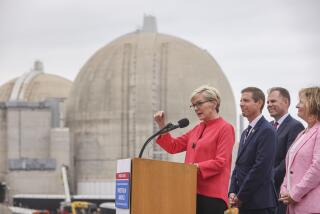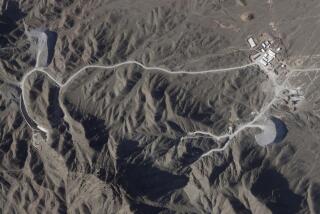Making Nuclear Bombs ‘Usable’
- Share via
WASHINGTON — The Pentagon has launched a fast-track program to develop computers that would help decide when nuclear weapons might be used to destroy deep underground bunkers harboring weapons of mass destruction or other critical targets, documents show.
The program, described in unpublished Pentagon documents obtained by The Times, seeks to design an array of high-speed computers that could take in structural and other data on a prospective underground target, calculate the amount of force needed to destroy it, then determine whether a nuclear “bunker buster” would be required.
In addition, the system -- supplemented by teams of experts -- would assess the potential for killing nearby civilians and inflicting other collateral damage, including the spread of radioactive dust thrown into the air by the nuclear device and the dispersal of toxic chemicals from weapons in the bunker.
The $1.26-billion program is the latest step in a little-publicized campaign by some senior administration officials, members of Congress and their supporters in the defense community to press for a new generation of smaller nuclear weapons as an alternative to the huge but obsolescent strategic missiles of the Cold War.
Both the White House and the Defense Department declined to comment.
“From the start of the Bush administration, we have seen increasing interest in ‘usable’ nuclear weapons,” said Christine Kucia, an analyst at the Arms Control Assn., a research organization that studies nonproliferation and other issues.
Defense analyst William M. Arkin, writing in The Times’ Jan. 26 Opinion section, reported a decision to examine possible roles for nuclear weapons in any war with Iraq. And the Washington Times reported last week that President Bush has approved nuclear weapons as an option for responding to attacks from weapons of mass destruction -- whether against the United States or its allies.
Advocates of considering new roles for nuclear weapons say that only by developing these smaller, tactical devices and their support systems can the United States deter rogue states and terrorist groups.
Existing strategic missiles are portrayed as too massively destructive to be a credible deterrent against an adversary such as Saddam Hussein. The U.S., these advocates say, could never use “city killers” against a terrorist group or a regional foe, especially in a sensitive area like the Middle East.
Critics, on the other hand, contend that pursuing new weapons makes their use more likely, breaks down a half-century-old taboo against considering their use except in the direst emergencies, and encourages other nations to seek their own nuclear weapons.
Also, some analysts argue, recent studies show that even small nuclear bunker busters would create so much collateral damage and set off such political shock waves that they would be impractical.
Kucia, a critic of the administration’s new initiatives, said nuclear devices “have been reserved for decades as the absolute weapons of last resort.”
“To put them in the realm of usable weapons is to take on a whole new definition that has never been explored and, frankly, should not be explored,” she added.
Although advocates of exploring new uses for nuclear weapons believe they could have broad applications, nuclear bunker busters have become the focal point of the larger debate.
The new program, described in two documents dated Jan. 29 and drafted by the Defense Threat Reduction Agency, appears to reflect that focus.
“In recent years,” one document says, “potential adversaries have gone to great lengths” to protect themselves against U.S. air attacks “by placing critical infrastructure and [weapons of mass destruction] in tunnels and other deeply buried locations, or by structurally hardening some buried targets.”
As a result, it says, the military “needs to consider and evaluate the option of using nuclear weapons against its most difficult targets.”
Robert Nelson, a Princeton University physicist and senior fellow for the Council on Foreign Relations who has studied nuclear weapons as possible bunker busters, believes they are impractical. Even smaller nuclear devices would throw off enough radioactive dirt and dust to kill tens of thousands of people if they were exploded underground in an urban environment.
Moreover, Nelson said, evidence suggests that a nuclear explosion could not be counted on to destroy chemical, biological or nuclear material stored in a deep bunker.
Instead, it would probably spread such material over a substantial area, he said.
“You would end up doing exactly the opposite of what you wanted to accomplish,” he said.
The problem, he said, is that earth-burrowing weapons cannot penetrate deep enough to destroy a heavily protected bunker without blowing out a large crater on the surface and leaking radioactive material into the air.
But advocates of nuclear bunker busters hold out hope that ways could be found to burrow them deep enough that no radioactive material would escape and other toxins would be destroyed. U.S. weapons designers have been studying earth-penetrating nuclear bombs since the 1950s because, if such a device can burrow even a short distance underground, the seismic power of its explosion is highly multiplied. The original goal was to build earth penetrators capable of wiping out the Soviet Union’s missile silos.
Last year, congressional advocates succeeded in appropriating $45 million for new research on a “robust deep earth penetrator.” The Pentagon’s new program has progressed to the point of requesting proposals from defense contractors to begin research and development on the target analysis system. At least some of the work would probably be done at Lawrence Livermore National Laboratory near Oakland and at the Sandia National Laboratories in New Mexico.
The new program is being carried out under the aegis of U.S. Strategic Command, or STRATCOM, a new joint command created to replace the Air Force’s old Strategic Air Command and the Space Command.
The Bush administration has given STRATCOM dramatically expanded responsibilities for developing strategies and weapons systems to combat rogue states, terrorist organizations and other potential adversaries -- including the possible use of nuclear weapons.
More to Read
Sign up for Essential California
The most important California stories and recommendations in your inbox every morning.
You may occasionally receive promotional content from the Los Angeles Times.













